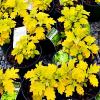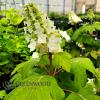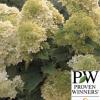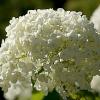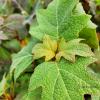Free gardening gloves when you spend $75.00 or more!
Hydrangea 'Little Honey'
Little Honey Hydrangea Bushes Hydrangea quercifolia 'Little Honey' grows in tight spaces or small yards where other oakleaf hydrangeas are too large. As with most Oakleaf Hydrangeas , they prefer soil rich in organic matter, that is well drained in full to part sun. Mulch for summer months to prevent soil moisture evaporation. This little gem will grow best in partially shaded areas. Leaves are a yellow to green shade or chartreuse. Wonderful showy foliage that will brighten up any landscape. Your Little Honey Hydrangea white flowering shrub blooms on old wood. While it doesn't necessarily...
- Read more about Hydrangea 'Little Honey'
- Log in or register to post comments
Hydrangea 'Ruby Slippers'
Ruby Slippers Oakleaf Hydrangea Bushes Hydrangea quercifolia 'Ruby Slippers' is a compact hydrangea growing only 3 to 4 feet tall and up to 3 to 5 feet wide. Just like it's Oakleaf Hydrangea relatives, the Ruby Slippers flowers emerge white in early summer maturing to ruby red as the season progresses. Large green oak-like leaves deepen to brilliant mahogany red for fall foliage. From large landscapes to small garden settings Ruby Slippers Oakleaf Hydrangea is a showy flowering shrub . With the Ruby Slippers ' four seasons of interest from late spring to early summer white blooms maturing to...
- Read more about Hydrangea 'Ruby Slippers'
- Log in or register to post comments
Limelight Hydrangea Bush
Buy Limelight Hydrangea Bushes Online Limelight Hydrangea Shrub is an exciting new hardy hydrangea from Holland. The Hydrangea Limelight has unique bright green blooms in mid-summer that holds it's bright and refreshing color right into early fall when the blooms change color to a rich deep pink. The autumn foliage display of green and pink blooms on the same plant is breathtaking! Even the fall color makes a great addition to your hydrangea garden and blends wonderfully with other colors. Use Limelight Hydrangeas in bouquets either fresh or dried to make a unique floral design. This...
- Read more about Limelight Hydrangea Bush
- Log in or register to post comments
Annabelle Hydrangea Bushes
Annabelle Hydrangea Bushes For Sale Annabelle Hydrangeas are our favorite choice for a white flowering shrub in partially sunny areas. Plant this white hydrangea shrub in morning sun with afternoon shade or dappled shade all day. In Northern climates, this shrub can be positioned in all day sun. Flowers of this smooth flowering shrub are large and rounded. These sterile white flowers open in May to June and often continue, even sporadically, into September. The huge dark green leaves of the Annabelle arborescens Hydrangea have serrated edges that turn yellow in fall. Discovered in the wild...
- Read more about Annabelle Hydrangea Bushes
- Log in or register to post comments
Pee Wee Oak Leaf Hydrangea
Hydrangea quercifolia 'Pee Wee' - The dwarf Pee Wee Hydrangea features white flowers in late spring into early summer which will gradually fade to shades of pink. As with Oakleaf Hydrangeas , the pee wee offers beautiful fall foliage . A small flowering shrub that mature in the 4 foot height range with a spread of up to 3 feet wide. Excellent for woodland garden settings. North American Native Hydrangea Shrub Spring Flowering Cinnamon color bark in winter Plant in groups for best colors Perfect plant for gift




